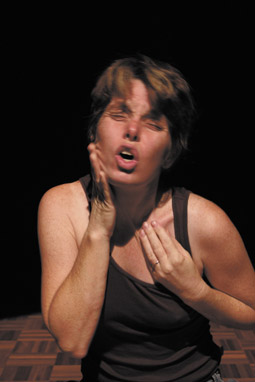 |
Vanessa Tomlinson, All Vinko: The Theatre of Music photo Sharka Bossakova |
The concert starts with Discours VIII for wind quintet (1984), scales rising at different rates to create a complex overlay of notes that sync up every so often, turn into drones, then start rising again. The performers move about, leave one standing alone in the central spotlight, return, stand with their backs to the audience, exchange conversational snippets of sound and gesture. The sound is beautifully balanced. The effect of the movement is formal, measured, music as re-enacted dance.
Next is Corporel for Body Percussion (1985). Tomlinson sits alone on the stage, hands over her face, forcing sound out of her mouth and through her fingers. She rubs her face, taps her head, taps a clavicle, leans back and slaps her hands down on the floor. She moves her hands across her body from top to bottom, scratches her hair in a systematic exploration of the spatial geometry of the head. The effect is discomforting, as though Tomlinson is visiting an unfamiliar body and checking the surface for defects. The personal is suppressed, the performer reduced to a vehicle for the expression of rules and the ordering of symbols.
Kvadrat for four percussionists (1989) follows. The performers sit facing outwards on chairs arranged in a square. Each chair has its own set of commonplace objects nearby. Water drips from hands, paper gets scrunched and shaken, carrots clap together, ropes get whipped, feet move, micro gestures make no sound, and at a cue—maybe a music box or an alarm clock sounds—the performers change places. It’s like a party where everyone gets to adopt positions, say their piece, but never actually speak to each other—although there is a final all-in-together singing of the universal OM. There seems to be a claim for percussion as a way of finding the meaning of the world by sounding its objects, or perhaps the claim is that the sounding gesture magically brings meaning to the objects it strikes. Again there is the indication that the performance of music has some function over and above the making of sound.
Another solo piece for Tomlinson, Pensée ecartalée for percussion solo (1997). Voice sounds and the hum of whirlies, coughing, moving from one bit of equipment to another, getting annoyed and hitting things in frustration. Like early tape music, this work of Globokar’s is very serial, one sound after another, with little or no overlapping between. But the gaps between the sounds aren’t long enough for the sounds to become things-in-themselves, not short enough for them to gestalt together into a rhythmic progression. On the up-side it reminds me of John Cage’s Water Walk (http://blog.wfmu.org/freeform/2007/04/john_cage_on_a_.html). However, the humour and musicality of Cage’s performance is missing. Comes across as a bit aimless in the end. The composer again seems to be using the performer to enact a behavioural sequence rather than seeking to engage them with the possibilities of performance.
The final, and oldest, work—Discours II for trombone quintet (1969)—is the strongest. To begin, we watch the performers getting ready to begin—making sounds with the mutes, banging the trombone bell, shuffling about with the gear. This gradually works into lots of breathy sounds and the usual fabulous farty resonance of the trombone—Globokar has been a virtuoso trombonist and it shows in this piece. There’s humming, laughs and chuckles, lots of vocalisations made through the instrument to transform the voice and situate the performer within the sound making. A soloist plays on all the time and the others pop in and out trying to get some sort of conversation going. Sparse and silent becomes waiting and preparation. The performers begin to grumble, pick up their mutes and one by one walk off, leaving the last soloist gabbling away like a TV left on by mistake in another room.
Clocked Out, All Vinko: The Theatre of Music; Queensland Conservatorium of Music, April 4, http://www.clockedout.org
RealTime issue #85 June-July 2008 pg. 49
© Greg Hooper; for permission to reproduce apply to [email protected]








 back
back